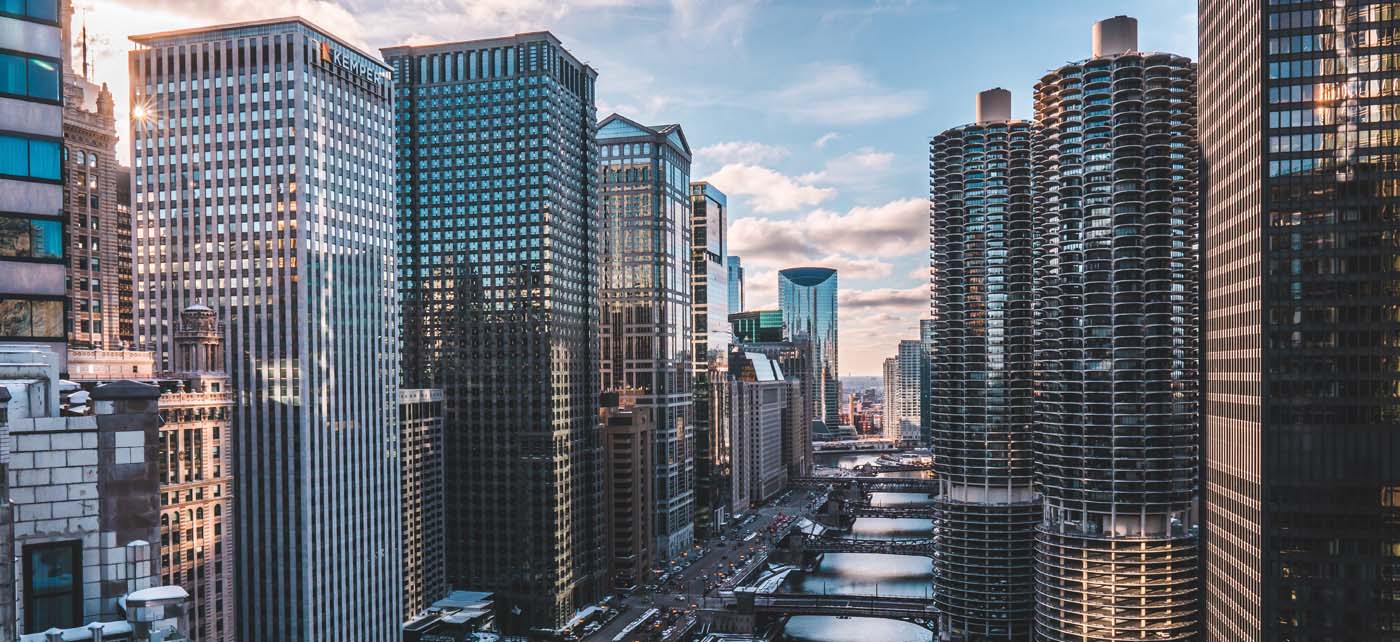Chicago is the biggest city and the most dynamic economic hub in the state of Illinois. The metropolitan area is home to nearly 10 million people, 35 Fortune 500 companies, a labor force of 4+ million people, and more than 500,000 businesses, a fifth of which are in Chicago alone.
Over the years, the city of Chicago has received multiple awards and distinctions, including Top Metro for Business Investment, U.S. City of the Future, and the Extreme Digital Innovation Award.
Key industries include professional and business services, education, healthcare, government, trade and transportation, finance, and manufacturing. Among the top employers are Amazon, Accenture, Walgreens, IBM, and Boeing.
In addition, growth opportunities exist for many office-using sectors, including admin support services, company management, as well as professional, scientific, and technical services.
In 2021, Chicago became one of the top 3 best cities for startups, attracting record levels of VC funds and a host of new unicorns looking to capitalize on the city's reputation as a leading innovation hub. The sectors attracting the most capital are deepTech, healthcare, hardTech, food and beverage.
During more than a decade, Chicago has been a leading destination for foreign investment in commercial real estate. Whereas prior to 2020, office buildings and hotels generated the highest demand, currently investor interest has shifted to trophy offices and industrial assets, like warehouses.
High interest levels are evidenced in increasing sales volumes, which in early 2022 reached $109bn for office assets and $102bn for retail and industrial space. Overall, nearly 2,000 foreign companies have chosen to set up operations in the Windy City, generating a total investment in excess of $140bn.
Office Space Market
Total office stock is in the region of 270 million square feet, with the Chicago CBD accounting for nearly 165 million of the total. The market is subdivided into several Loop sub-markets (central, east, south, west, and far west), Fulton, North Michigan Avenue, River North and River West.
Non-CBD offices are mainly in Clybourn Corridor and Goose Island. In suburban Chicago, workspace amounts to approximately 100 million square feet, mainly located in O'Hare and the counties of North Cook and North Lake.
Offices in Chicago's CBD
An analysis of the current conditions in Chicago's CBD office market shows excellent indicators. Absorption levels continue to increase on a quarterly basis, and in mid 2022 they reached their highest level since 2020. With more than 370,000 square feet absorbed in a single quarter, Chicago's CBD has the highest absorption rate in the United States.
Increasing lease volumes are another positive sign for this market. Active space requirements in excess of 7.5 million confirm that demand for offices remains strong and tied to rising transaction levels.
Total vacancy rates in the CBD average 19%, with significant variation across different sub-markets. For example, vacancy rates in South Loop approach 40%, whereas they are tight at 12% in North Michigan Avenue.
Average direct asking rates for CBD locations are $46 / psf, and are well above that figure in Fulton Market, West Loop and River North. By contrast, the lowest asking rates for offices are found in River West and Far West Loop, where they are in the $30s.
Average values for Class B and Class C offices have only increased slightly during the past five years, rarely exceeding the $30s in the most desirable areas.
Newly built offices and those with high specs continue to outperform all other asset classes in terms of demand and asking rents. Improved workplace standards are the key theme influencing talent attraction and the return to the office, so many tenants are willing to invest in higher quality premises.
Non-CBD and suburban office space in Chicago
This market consists of more than 100 million square feet, with the biggest clusters being in the northwest and eastern areas. By asset class, the inventory breakdown is 55 million square feet for Class A offices, 40 million for Class B, and 7 million for Class C.
Vacancy rates here range from 13% in Clybourn Corridor, to 34% in the northwest region, which is also one of the most active in terms of absorption along with North Lake County.
Average direct asking rates fall within the mid $20s to mid $30s range. The priciest assets are in Goose Island, and the most affordable in the northwestern neighborhoods.
Despite office job losses, office GDP is rising to be in line with the national average, which should sustain demand at least at current levels. The market's overall performance will depend on macroeconomic trends, as small and medium-sized occupiers are still reluctant to commit to properties in areas that have experienced a major exodus, such as the Loop.
Chicago Retail Space
Industrial commercial real estate continues to gather strength, especially in the most established sub-markets (O'Hare, Western Cook County, South Chicago, and South I-55).
Vacancy rates for industrial properties in the Chicago area reached historical lows in 2022, averaging 4.2%. Although vacancy rates vary from area to area, in no case are they higher than 8%, and in some cases they can be as low as 1% - for example, along the South I-55.
Robust absorption levels are another trait that characterizes this market, with take up rates exceeding 30 million square feet per year in the recent past. These factors combined led to rising rental rates, which average nearly $7.5 / psf (NNN).
In terms of sales and new developments, the industrial market is expected to stabilize as interest and cap rates climb and many developers and occupiers remain cautious until new values settle.

